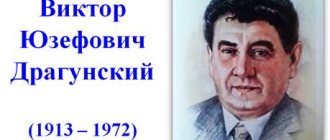Project "I. A. Krylov and his fables"
Dina Kudasova
Project "I. A. Krylov and his fables"
Project topic : Ivan Andreevich Krylov
Relevance of the topic: when analyzing conversations with children, it was revealed that children do not use figurative expressions, metaphors, and epithets in their speech. The fable is a genre of fiction in which the means of artistic expression are widely represented: comparisons, metaphors, figurative expressions (including proverbs, sayings, as well as many popular expressions . One of the techniques for writing a fable was dialogical speech between the heroes of fables, which is a model for formation of dialogue in children's speech. Why fable ? This genre is close to children in many ways. The characters in fables are animals and beasts. Events unfold quickly, the content of fables can be easily retold and dramatized. After reading, it is not difficult to have conversations of a moral nature. They help fables and mental development, as they teach to see their hidden meaning behind the events and phenomena of everyday life, to understand human characters, to evaluate people’s actions, to grasp their funny sides, which cultivates observation, a sense of humor and wit.
Participants: children, teachers and parents.
Dates: February-March.
Goal: to expand children's understanding of the work of I. A. Krylov ; develop the moral qualities of children; create conditions for the active use of children's literary experience in their everyday and creative activities.
Tasks:
1. To develop the ability to identify a fable as a genre of literature based on its characteristic features, and to find morality in a work. Cultivate sensitivity to the figurative structure of the fable . Develop accuracy, expressiveness, clarity of presentation of thoughts; consolidate children’s ability to use means of artistic expression in speech; develop memory, cultivate a love of literature.
2. Carry out moral and ethical education of children with the help of Krylov’s .
3. Improve the teaching skills of parents. Demonstrate the complexity and ambiguity of the fable genre and the role of morality in it ; develop a sustainable interest in the book as an independent visual object of literature.
4. Continue to improve children’s artistic and speech performing skills.
5. Develop children's search activity.
6. Strengthen the ability to convey images of characters through visual activity, introduce children to theatrical art, improve the dialogical form of speech, enrich the vocabulary with figurative expressions, comparisons, epithets, and cultivate skills in theatrical culture of activity.
7. Draw the attention of parents to the progress of the educational process in the field of “reading fiction”
, to guide parents in the choice of works of art (fables aimed at developing the child’s artistic taste, to involve parents in productive activities.
Forms of work: cognitive-game, productive, work with parents.
Expected results: These forms of work on familiarization with the fables of I. A. Krylov will teach the child to not only perceive the content in an original, unusual, in his own way, but also to creatively transform, think, draw conclusions, prove. They will serve as an effective means of mental, moral and aesthetic education, enrich his emotions, and teach him excellent examples of the Russian literary language, without which successful schooling is impossible.
Project implementation plan .
1. Acquaintance with the biography of I. A. Krylov . Selection of illustrative material.
2. Selection of audio recordings of Krylov’s .
3. GCD (x\literature; drawing)
.
4. Leisure evenings with listening to Krylov’s .
5. Design of the didactic game “Which fable is the hero ”; “Continue the proverb, saying”; "Find a couple."
6. Role-playing game “Mail”, plot: “Write a letter to the hero of the fairy tale.”
7. Consultation for parents: “The influence of theatrical play on the formation of personal competencies of a preschool child.”
8. Involving parents in creating homemade books with their children based on Krylov’s fables .
9. Work in the theater corner based on by I. A. Krylova “Swan, Crayfish and Pike.”
10. Competition for reciters of Krylov’s .
11. Compilation of the album “ Winged expressions from Krylov’s fables ”.
12. Compiling a crossword puzzle based on by I. A. Krylova .
Project business card :
When there is no agreement among the comrades, their business will not go well, and nothing will come out of it, only torment. (I. A. Krylov )
Literature: Krotova T.V. » Interaction of teachers, parents and students. Project methodology . Directory of the senior educator" No. 4 2007.
Biography
Russian fable : the great Russian fabulist I. A. Krylov
Ivan Andreevich Krylov was born in 1769 in Moscow. His father, Andrei Prokhorov, served in border garrisons. He did not encourage his son’s literary interests. Mother: Maria Alekseevna, on the contrary, took care of his education, aroused in him an interest in books and a love of reading. The boy does not teach at school due to lack of money. He independently studied Russian foreign languages, literature, mathematics, drew beautifully, and played the violin. Andrei Prokhorovich was seriously ill and died when Krylov was only 9 years old . Vanya was the eldest son in the family. He inherited from his father a dilapidated chest with books that Krylov the father had collected all his life .
There were no other valuables in the Krylovs’ poor house , so Ivan Andreevich early had to take care of his family, his younger brother Lev. Krylov writing only at the age of 37. In total, he wrote 205 fables.
Contrary to popular belief, Krylov did not compose his fables, or , say, most of the fables, to order. He always carried long pieces of paper with him and, when inspiration struck him, he wrote down his next work on them.
Krylov's fables since childhood. Krylov’s images are stored in our memory , which often pop up in our heads in various life situations; we turn to them and each time we never cease to be amazed at Krylov’s .
Nowadays, Krylov's has gone far beyond national boundaries. Krylov sounds not only in Russian and in the languages of the peoples of the Soviet Union, but also in almost all languages of the world. Krylov's fables have been translated into more than fifty languages. Ivan Andreevich's skill lies in the universality of his works. Written for specific events, due to their ambiguity, they can be applied to any suitable moment. They exist outside of time and space, this is their main advantage. They are as relevant today as they were a hundred years ago. How to explain this phenomenon? It has many components: this is Krylov’s , which found its outlet in satire, in the genre of fables. And the beautiful, figurative and laconic language that the author so masterfully uses, moving from literary to colloquial, and sometimes even dialect. And, of course, knowledge of the material that Ivan Andreevich writes about.
Project of an electronic manual on literature grade 5 I. A. Krylov. Selected fables. - presentation
Project of an electronic manual on literature grade 5 I. A. Krylov. Selected Fables
“I love, where there is an opportunity, to pinch vices!”
Contents Slide numbers “Who has not heard his living word?” From the biography At the origins of the genre. Fable as a genre Winged expressions from the fables “The Wolf in the Kennel” “The Pig under the Oak” “The Crow and the Fox” What the fable teaches Materials used Slide 19 Slide 20 Slide 21 Slide 23 Slides 5 -7 Slides Slides Slides Slide 4
Who has not heard his living words? Who hasn’t met him in their life? The immortal creations of Krylov Every year we love more and more. From the school desk we got along with them, In those days we barely comprehended the ABC book. And Krylov’s winged words remained in my memory forever. M. Isakovsky K. Bryullov. Portrait of I. A. Krylov
Ivan Andreevich Krylov was born into a poor noble family and therefore did not receive any education. Initially, Ivan Andreevich was taught writing and reading by his father, and then he developed a desire for literature thanks to his mother. The teaching was easy for Krylov. The varied abilities of Ivan Andreevich were especially noticeable from childhood. After the death of his father, his mother took over the upbringing and education of his sons Ivan and Lev. Since his father was the sole breadwinner of the family, Ivan began working in the Kalyazinsky Zemstvo Court from childhood, then in the Tver Magistrate. Due to a lack of money, Krylov worked with the Lvovs, and study became the payment for his work.
Krylov moved to St. Petersburg in 1782 with the Lvovs. From 1783 he served in the Treasury Chamber in St. Petersburg and was actively engaged in self-education. In addition to French, he learned to read and write German and Italian. He played the violin well, learned music theory, and understood mathematics. At the Lvovs and, possibly, at the playwright Ya. B. Knyazhnin, Krylov met almost everyone, a rather narrow circle of writers and art connoisseurs of that time, including G. R. Derzhavin and his wife, who patronized Krylov. A group of writers in the Summer Garden. Left: I. A. Krylov
In 1855, a bronze monument to the great fabulist was erected in the Summer Garden of St. Petersburg. Baron Pyotr Karlovich Klodt won the competition for the best project. He worked on the monument together with artists K. Bryullov and Agin. Krylov is depicted sitting in a chair, thoughtful. On each side of the pedestal there are bas-relief images of characters from Krylov’s most famous fables.
Aesop is an ancient Greek fabulist (VI century BC), considered the creator of the fable. La Fontaine Jean de (1621 - 1695) - French poet, famous as a fabulist
M. V. Lomonosov I. I. Khemnitser V. I. Maikov A. P. Sumarokov I. A. Krylov
A short story, often poetic, 2 parts: main narrative and morality (moral teaching) Allegory (allegory) Satirical depiction Heroes are often animals Dialogue Use of colloquial vocabulary Laconism Aphoristic language Special fable verse (lines of different lengths) conveying colloquial speech Personifications
One speaks, shames, convinces, and the other, not paying attention, continues to do something bad. They say when they want to emphasize that it is useless to persuade in cases where decisive measures are needed, not words. Artist A. M. Savchenko
It is usually said in a situation where a lot of time has passed and things have not moved forward. How many times have they said that you need to prepare for each lesson, “but things are still there” - again you were not prepared.
Instead of criticizing the shortcomings of others, it is better to see if you yourself have them. It is usually said ironically in a situation where someone points out to another the shortcomings that he himself has. Each of us, to one degree or another, must first of all “turn on ourselves”, be stricter with ourselves. Kuma (obsolete, colloquial) – here: friend, an appeal to a female representative. Artist G. Kupriyanov
Mutual praise is not sincere. They say ironically when one praises another because he praised him. Artist G. Kupriyanov
“The Wolf in the Kennel” is a response to the events of the war of 1812, when Napoleon entered Moscow, abandoned by the Russian commander Kutuzov, and realized that the Russian army was not defeated, but was gaining strength. The great Russian fabulist captured these events in his fable, then sent the fable to Kutuzov, who, having read it aloud after the battle under the red, bared his head, showing his gray hair. Artist A. M. Savchenko
How do the lines of the fable resonate with the real events of the War of 1812? How do the lines of the fable resonate with the real events of the War of 1812? Artist E.M. Rachev Here, the Hunter means the great Russian commander M.I. Kutuzov, and the Wolf means Napoleon.
The expression “got into the kennel” has an additional meaning: the word “got into the kennel” carries a connotation of surprise, and the kennel is not a sheepfold, the dogs can protect themselves. “The courtyard rose” means that the whole people began to fight with the Wolf. The direct meaning of the phrase “and instantly the gates are locked” is complemented by a figurative one: the Russian army, having made a maneuver and reached the Kaluga road, closed the escape routes for Napoleon in the area where there were food supplies. The wolf hid in a corner, “his fur bristling, his eyes seemed to want to eat everyone.” The Russian people have a proverb: “An eye sees, but a tooth hurts.” Wolf-Napoleon wants to conquer all of Russia, but cannot. His possibilities are less than his desires.
“Entered negotiations” means “started negotiations.” “Started” is in this case a synonym for the word “started.” But “let go” sounds more expressive. “Let’s establish a common harmony” means “let’s conclude a peace treaty.” Wolf-Napoleon invites the Russian Tsar to become an ally and “squabble,” that is, to fight on the side of Russia. “Not making peace” means not concluding a peace treaty. “Release a pack of hounds on the Wolf” - give the army the command to pursue the retreating French in order to drive them out of the country.
"Pig under the Oak." Artist G. Kupriyanov What phenomenon of life does the fable allegorically describe? What do you think of the Pig? What lines contain the moral of the fable? Create your own illustrations for the fable.
"A Crow and a fox". Hood. G. Kupriyanov Compare I. A. Krylov’s fable “The Crow and the Fox” with the fables of Aesop and Lafontaine. What do fables have in common and how do they differ? What is the meaning of morality? What situation supports this moral? What qualities do fabulists condemn and ridicule? Whose fable seems more expressive to you?
I. A. Krylov’s fables teach us to be kind, honest, and fair. Although fables involve animals, birds, or objects, we understand that they are about people. The author helps us evaluate their actions.
Materials used Zolotareva I.V., Egorova N.V. Lesson developments in literature. 5th grade. – M.: Vako, Literature. 5th grade. Textbook-reader in two parts. Part 1. Compiled by V. Ya. Korovin and others - M.: Enlightenment, Literature Lessons of Cyril and Methodius. 5th grade Internet resources: Interactive test tasks based on the fables of I. A. Krylov. Cartoon based on the fable “The Crow and the Fox”. Material for completing design tasks. Access mode collection.edu.ru/catalog/search/?text=%C1%E0%F1%ED%E8+%CA %F0%FB%EB%EE%E2%E0&context=current&interface=pupil&class% 5B%5D=47&subject% 5B%5D=10 collection.edu.ru/catalog/search/?text=%C1%E0%F1%ED%E8+%CA %F0%FB%EB%EE%E2%E0&context=current&interface=pupil&class% 5B%5D =47&subject%5B%5D=10 n.ru/communities.aspx?cat_no=2168&lib_no=21422&tmpl=lib&page= 1







